
I often see people send me messages, “What if you fail the Microsoft MD-101 exam?” The fact that the Microsoft MD-101 exam is more stressful is well known. Today to bring you a solution, I feel you need MD-101 dumps to help relieve stress and boost confidence.
Ease MD-101 exam stress plan: Download Pass4itSure MD-101 dumps 2023 https://www.pass4itsure.com/md-101.html (latest update, 414+ new issues, PDF+VCE format).
How to study stress-free
Studying for the Microsoft MD-101 exam requires skill. In any skill, practice is the key to success. However, time and effort are not enough. Just like participating in sports, certain basic principles must be adhered to achieve the best results.
Unstable study habits can produce bad results. So you need the help of the latest MD-101 dump 2023, which gives you a specified plan, step by step.
Choose the right MD-101 dumps to ease your exam stress
Choosing the right MD-101 dumps is critical to ensure your exam success. As a solution, Pass4itSure is a great choice, it is a consolidation of the latest MD-101 exam learning materials, providing you with the latest exam practice questions, all about the real exam content.
It is a collection of questions distilled from painstaking work, preparation, and constant feedback from Pass4itSure experts, and by practicing it, you will easily pass the MD-101 exam without stress.
Pre-test yourself!
Review practice many times, which is beneficial for the MD-101 exam. It is not only good to understand the content of the exam, but also to be familiar with the question types of the exam.
To allow you to practice better, we provide free MD-101 online test questions for learning:
Question 1:
Your company has several Windows 10 Microsoft Azure Active Directory (Azure AD) joined workstations. These workstations have been enrolled in Microsoft Intune. You are creating a device configuration profile for the workstations.
You have been informed that a custom image should be displayed as the Desktop background picture. Which of the following is a Device restriction setting that should be configured?
A. Locked screen experience
B. Personalization
C. Display
D. General
Correct Answer: B
Wallpaper image, or Desktop background picture, URL is set under Personalization.
References: https://docs.microsoft.com/en-us/intune/device-restrictions-windows-10
Question 2:
Note: This question is part of a series of questions that present the same scenario. Each question in the series contains a unique solution that might meet the stated goals. Some question sets might have more than one correct solution, while
others might not have a correct solution.
After you answer a question in this section, you will NOT be able to return to it. As a result, these questions will not appear on the review screen.
You have a computer that runs Windows 8.1. Two days ago, you upgraded the computer to Windows 10. You need to downgrade the computer to Windows 8.1.
Solution: You restart the computer to Windows Recovery Environment (Windows RE) and use the Advanced options. Does this meet the goal?
A. Yes
B. No
Correct Answer: A
Tested on W8.1 > Upgrade to W10. After the upgrade is completed, restart WinRE. From winRE > Avanced Options > uninstall last Features Updates. The computer restarted, uninstalls W10 and I could log on to win 8.1 – the answer is YES.
This Microsoft doc says the answer should be “YES”
Here is how:
“Reset this PC and Go back buttons in Settings > System > Recovery do not function. Reset and rollback can be accessed from the Windows Recovery Environment by selecting System > Recovery > Advanced startup, and pressing Restart
now. Once in Windows Recovery, choose Troubleshoot.
Choose Reset this PC to perform a reset.
Choose Advanced options > Uninstall Updates > Uninstall latest feature update to perform a rollback.”
Question 3:
You have a server that runs the Microsoft Deployment Toolkit (MDT). You have computers that run Windows 8.1 or Windows 10.
You have a Microsoft 365 tenant. Microsoft 365 Enterprise E5 licenses are assigned to all users.
You need to recommend a strategy to install Windows 10 on Windows 8.1 computers. The installation must retain the user files, settings, and supported applications.
What should you recommend?
A. Refresh the Window 8.1 computers by using Windows 10 and use the User State Migration Tool (USMT).
B. Perform an in-place upgrade of Windows 8.1 to Windows 10.
C. Refresh the Window 8.1 computers by using Windows 10 and use Windows Autopilot white glove service to finalize the installation.
D. Refresh the Window 8.1 computers by using Windows 10 and use Windows Autopilot user-driven mode.
Correct Answer: B
The simplest path to upgrade PCs currently running Windows 7, Windows 8, or Windows 8.1 to Windows 10 is through an in-place upgrade. You can use a Microsoft Endpoint Manager task sequence to completely automate the process.
Note: For Windows 10 deployment, Microsoft 365 includes a fantastic deployment advisor that can walk you through the entire process of deploying Windows 10.
The wizard supports multiple Windows 10 deployment methods, including:
Windows Autopilot
In-place upgrade Deploying Windows 10 upgrade with Intune
Deploying Windows 10 upgrade with Microsoft Endpoint Configuration Manager
Deploying a computer refresh with Microsoft Endpoint Configuration Manager
Reference:
https://docs.microsoft.com/en-us/windows/deployment/deploy-m365 https://docs.microsoft.com/en-us/windows/deployment/deploy-windows-cm/upgrade-to-windows-10-with-configuration-manager
Question 4:
You use Microsoft Intune to manage client computers. The computers run one of the following operating systems:
1.Windows 8.1
2.Windows 10 Pro
3.Windows 10 Enterprise
4.Windows 10 Enterprise LTSC
You plan to manage Windows updates on the computers by using update rings.
Which operating systems support update rings?
A. Windows 10 Pro, Windows 10 Enterprise, and Windows 10 Enterprise LTSC only
B. Windows 8.1, Windows 10 Pro, Windows 10 Enterprise, and Windows 10 Enterprise LTSC
C. Windows 10 Enterprise and Windows 10 Enterprise LTSC only
D. Windows 10 Pro and Windows 10 Enterprise only
Correct Answer: D
D. Windows 10 Pro and Windows 10 Enterprise only
Update rings are supported for the following Windows editions:
Windows 10/11 Pro
Windows 10/11 Enterprise
Windows 10/11 Team – for Surface Hub devices
Windows Holographic for Business
Update ring policies are supported for devices that run Windows 10 version 1607 or later, and Windows 11
Incorrect:
The Long-Term Servicing Channel (LTSC) is designed for Windows 10 devices and use cases where the key requirement is that functionality and features don’t change over time. Examples include medical systems (such as those used for
MRI and CAT scans), industrial process controllers, and air traffic control devices.
These devices share characteristics of embedded systems: they are typically designed for a specific purpose and are developed, tested, and certified before use.
They are treated as a whole system and are, therefore, commonly upgraded by building and validating a new system, turning off the old device, and replacing it with a new, certified device.
Reference: https://docs.microsoft.com/en-us/mem/intune/protect/windows-update-for-business-configure https://techcommunity.microsoft.com/t5/windows-it-pro-blog/ltsc-what-is-it-and-when-should-it-be-used/ba-p/293181
Question 5:
You have a Microsoft 365 E5 subscription that contains a user named User1 and the devices shown in the following table.

User1 can access her Microsoft Exchange Online mailbox from both Device 1 and Device 2.
You plan to create a Conditional Access policy named CAPolicy1 that will have the following settings:
1.Assignments
2.Users or workload identities: User1
3.Cloud apps or actions: Office 365 Exchange Online
4.Access controls
5.Grant: Block access
You need to configure CAPolicy1 to allow mailbox access from Device 1 but block mailbox access from Device 2.
Solution: You add a condition that specifies a trusted location.
Does this meet the goal?
A. Yes
B. No
Correct Answer: B
Instead, use solution: You add a condition to filter for devices.
Note: Conditional Access: Filter for devices
When creating Conditional Access policies, administrators have asked for the ability to target or exclude specific devices in their environment. The conditioning filter for devices gives administrators this capability.
Now you can target specific devices using supported operators and properties for device filters and the other available assignment conditions in your Conditional Access policies.
Question 6:
You have devices enrolled in Microsoft Intune as shown in the following table.

You create an app protection policy named Policy1 that has the following settings:
1. Platform: Windows 10
2. Protected apps: App1
3. Exempt apps: App2
4. Network boundary: Cloud resources, IPv4 ranges
You assign Policy1 to Group1 and Group2. You exclude Group 3 from Policy 1.
Which devices will apply to Policy 1?
A. Device1, Device2, Device4, and Device5
B. Device1, Device4, and Device5 only
C. Device4 and Device5 only
D. Device1, Device3, Device4 and Device5
Correct Answer: C
Intune devise configuration profiles let you include and exclude groups from profile assignments. Exclusion takes precedence over inclusion in the same group types.
Policy1 excludes Group3 and Group3 includes Device1, Device2, and Device3.
Incorrect Answers:
A, B, D: Device1, Device2, and Device3 are members of Group3. Policy1 excludes Group3. Exclusion takes precedence over inclusion.
Reference:
https://docs.microsoft.com/en-us/intune/app-protection-policies
Question 7:
You have a Microsoft 365 tenant that uses Microsoft Intune.
You use the Company Portal app to access and install published apps to enrolled devices.
From the Microsoft Endpoint Manager admin center, you add a Microsoft Store app.
Which two App information types are visible in the Company Portal?
NOTE: Each correct selection is worth one point.
A. Information URL
B. Owner
C. Privacy URL
D. Developer
Correct Answer: AC
Information URL: The information URL will be visible to users in Company Portal.
Privacy URL: The privacy URL will be visible to users in Company Portal.
Incorrect answers:
Developer: This information will be visible to people signed into the admin center.
Owner: This name will be visible to people signed in to the admin center.
Reference:
https://docs.microsoft.com/en-us/mem/intune/apps/store-apps-windows
Question 8:
Your company makes use of Microsoft Intune to manage the Windows 10 computers that run.
After creating an app protection policy for Microsoft Edge, you assign the policy to a group.
After opening Microsoft Edge on one of the computers, you decide to check whether the app protection policy is protecting Microsoft Edge on the computer.
You plan to add a column in Task Manager to achieve this.
Which of the following is the column that should be added?
A. Base priority
B. Command line
C. Enterprise context
D. DPI awareness
Correct Answer: C
References: https://docs.microsoft.com/en-us/windows/security/information-protection/windows-information-protection/wip-app-enterprise-context https://www.itpromentor.com/win10-mam-wip/
Question 9:
HOTSPOT
Your network contains an Active Directory domain. The domain contains 200 computers that run Windows 8.1. You have a Microsoft Azure subscription.
You plan to upgrade the computers to Windows 10.
You need to generate an Upgrade Readiness report for the computers.
What should you do? To answer, select the appropriate options in the answer area.
NOTE: Each correct selection is worth one point.
Hot Area:
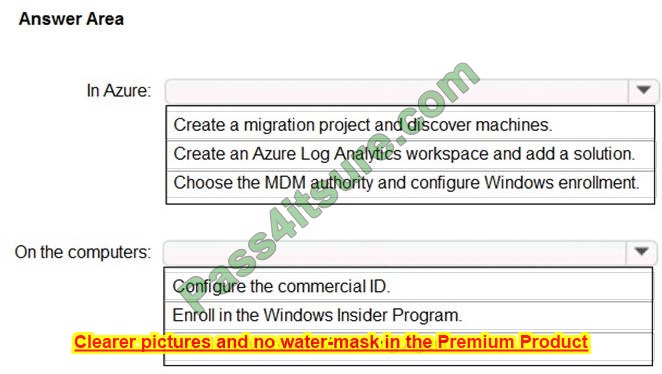
Correct Answer:
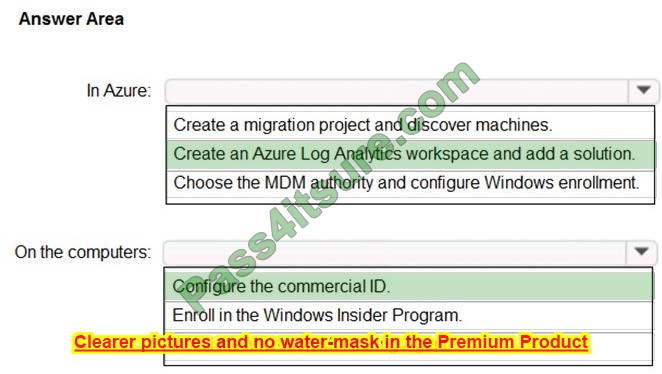
Box 1: Create an Azure Log Analytics workspace and add a solution
Once you have an Azure subscription, follow the steps below to get started with Upgrade Readiness.
Set up a subscription to Microsoft Operations Management Suite (OMS).
You will be prompted to link the OMS workspace to an Azure subscription.
Once the link with an Azure subscription is complete, your workspace should be ready and you will be redirected to your blank workspace.
Enable Upgrade Analytics. To do this, click on the Solutions Gallery In the Solutions Gallery page, scroll to the right to locate and select the Upgrade Analytics
(Preview) tile.
..
Now that your Upgrade Analytics subscription is ready, the last requirement is to configure Upgrade Analytics with the details of which version of Windows 10 you are targeting. To do this, click on the tile for Upgrade Analytics Preview. On the
Upgrade Analytics Preview page, click on the gear icon labeled Solution Settings.
Box 2: Configure the Commercial ID
For the commercial value variable, use the “Commercial ID” that was generated when you set up your Upgrade Readiness solution. If you don’t have this, you can pull it out from your OMS workspace.
Reference:
https://techcommunity.microsoft.com/t5/core-infrastructure-and-security/getting-started-with-upgrade-readiness/ba-p/714705 https://docs.microsoft.com/sv-se/archive/blogs/ukplatforms/upgrade-readiness-client-configuration
Question 10:
You need to consider the underlined segment to establish whether it is accurate.
Your company\’s Microsoft Azure subscription includes an Azure Log Analytics workspace.
After deploying a new Windows 10 computer, which belongs to a workgroup, you are tasked with making sure that you can utilize Log Analytics to query events from the new computer.
You configure the new computer\’s commercial ID.
Select “No adjustment required” if the underlined segment is accurate. If the underlined segment is inaccurate, select the accurate option.
What should you do on Computer1?
A. No adjustment is required.
B. install the Azure Diagnostic extension on the new computer
C. install the Dependency agent on the new computer
D. install the Microsoft Monitoring Agent on the new computer
Correct Answer: D
The Azure Monitor agent (AMA) collects monitoring data from the guest operating system of Azure and hybrid virtual machines and delivers it to Azure Monitor where it can be used by different features, insights, and other services such as Microsoft Sentinel and Microsoft Defender for Cloud.
Reference: https://docs.microsoft.com/en-us/azure/azure-monitor/agents/azure-monitor-agent-migration
Question 11:
You have a shared computer that runs Windows 10.
The computer is infected with a virus.
You discover that a malicious TTF font was used to compromise the computer.
You need to prevent this type of threat from affecting the computer in the future.
What should you use?
A. Windows Defender Exploit Guard
B. Windows Defender Application Guard
C. Windows Defender Credential Guard
D. Windows Defender System Guard
E. Windows Defender SmartScreen
Correct Answer: A
Question 12:
Note: This question is part of a series of questions that present the same scenario. Each question in the series contains a unique solution that might meet the stated goals. Some question sets might have more than one correct solution, while others might not have a correct solution.
After you answer a question in this section, you will NOT be able to return to it. As a result, these questions will not appear on the review screen.
You have an Azure Directory group named Group1 that contains Windows 10 Enterprise devices and Windows 10 Pro devices.
From Microsoft Intune, you create a device configuration profile named Profile1.
You need to ensure that Profile 1 applies to only the Windows 10 Enterprise devices in Group 1.
Solution: You create an Azure Active Directory group that contains only the Windows 10 Enterprise devices. You assign Profile 1 to the new group.
Does this meet the goal?
A. Yes
B. No
Correct Answer: B
Instead: You configure an applicability rule for Profile1. You assign Profile1 to Group1.
Note: Applicability rules allow administrators to target devices in a group that meets specific criteria. For example, you create a device restrictions profile that applies to the All Windows 10/11 devices group. And, you only want the profile assigned to devices running Windows Enterprise.
To do this task, create an applicability rule.
Reference:
https://docs.microsoft.com/en-us/mem/intune/configuration/device-profile-create
Question 13:
HOTSPOT
You create a Windows Autopilot deployment profile.
You need to configure the profile settings to meet the following requirements:
1. Automatically enroll new devices and provision system apps without requiring end-user authentication.
2. Include the hardware serial number in the computer name.
Which two settings should you configure? To answer, select the appropriate settings in the answer area.
NOTE: Each correct selection is worth one point.
Hot Area:
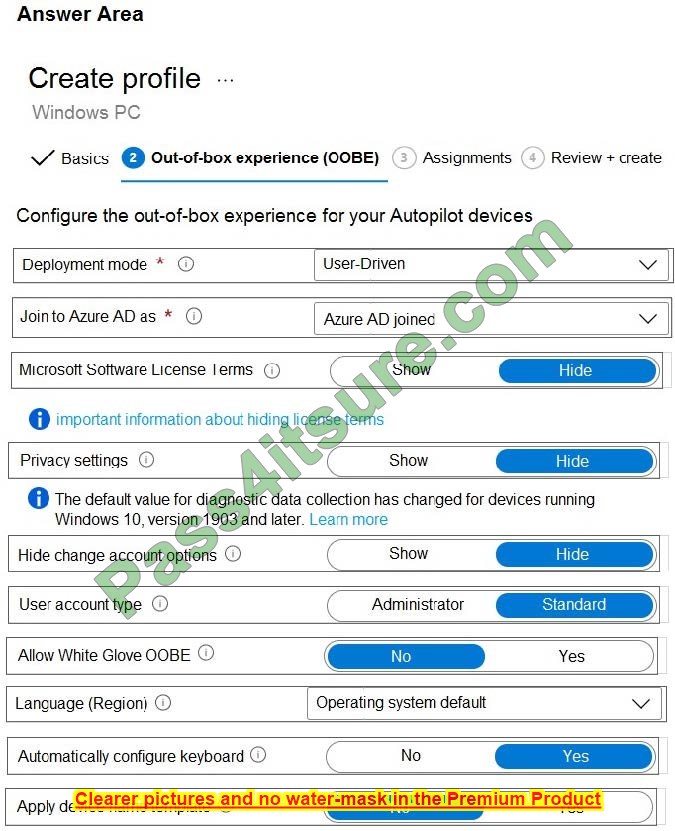
Correct Answer:
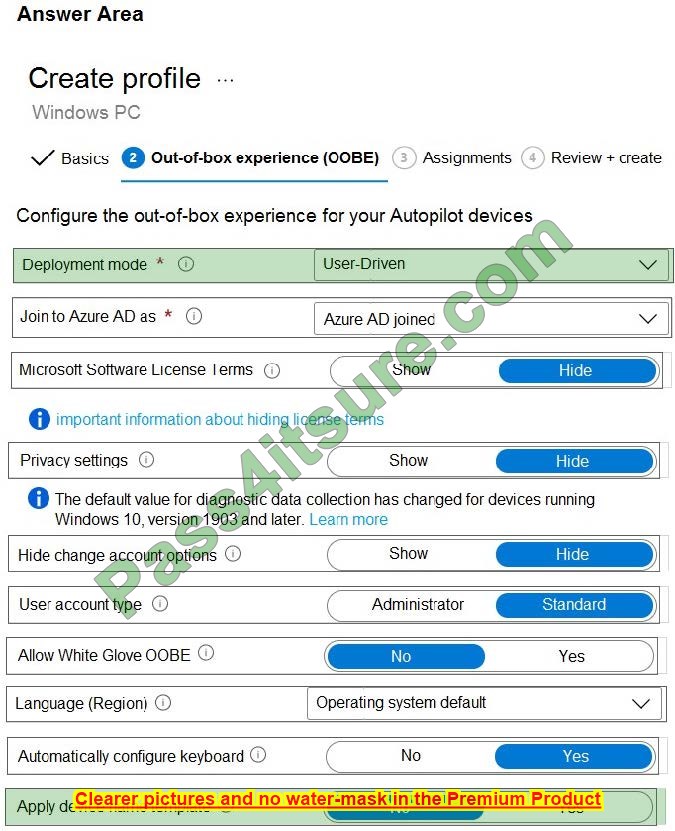
Box 1: Deployment mode User-driven
User-driven: Devices with this profile are associated with the user enrolling the device. User credentials are required to enroll the device.
Change it to Self-deploying (preview): (requires Windows 10, version 1809 or later) Devices with this profile aren\’t associated with the user enrolling the device.
User credentials aren’t required to enroll the device. When a device has no user associated with it, user-based compliance policies don’t apply to it. When using the self-deploying mode, only compliance policies targeting the device will be applied.
Box 2: Apply device name template
Apply device name template (requires Windows 10, version 1809 or later, and Azure AD join type): Choose Yes to create a template to use when naming a device during enrollment. Names must be 15 characters or less and can have letters,
numbers, and hyphens. Names can’t be all numbers. Use the %SERIAL% macro to add a hardware-specific serial number. Or, use the %RAND:x% macro to add a random string of numbers, where x equals the number of digits to add.
Reference:
https://docs.microsoft.com/en-us/mem/autopilot/profiles
Question 14:
HOTSPOT
You implement the planned changes for Connection1 and Connection2.
How many VPN connections will there be for User1 when the user signs in to Device1 and Device2? To answer, select the appropriate options in the answer area.
NOTE: Each correct selection is worth one point.
Hot Area:
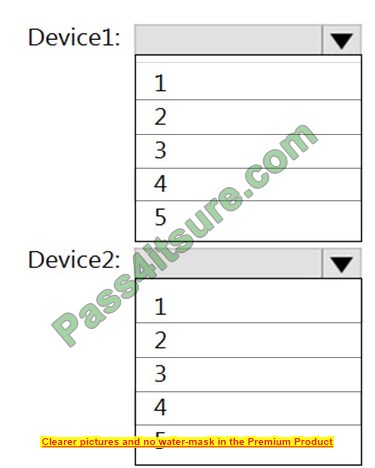
Correct Answer:
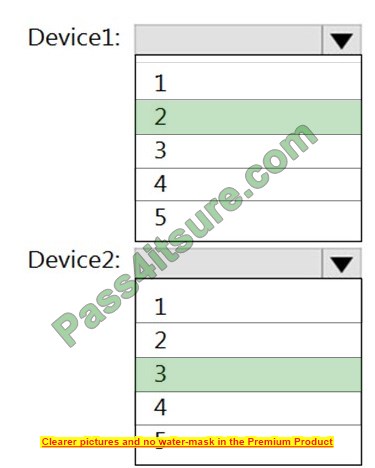
Box 1: 2 Device 1 has VPN1 and VPN2.
Box 2: 3 Device2 has VPN1, VPN2 (group assignment), and VPN3
Question 15:
Your company has an Active Directory domain, named weylandindustries.com. the domain is synced to Microsoft Azure Active Directory (Azure AD) and all company computers have been enrolled in Microsoft Intune.
You are preparing to perform a Fresh Start action on certain company devices.
Which of the following operating systems support the Fresh Start action? (Choose all that apply.)
A. Windows Vista
B. Windows 8.1
C. Windows 10
D. iOS
Correct Answer: C
The Fresh Start device action removes any apps that are installed on a PC running Windows 10, version 1709 or later.
References: https://docs.microsoft.com/en-us/intune/device-fresh-start
Or download the newest MD-101 PDF: https://drive.google.com/file/d/1kBcLVLPJ4ABqVwq-bE16ceGCXG_uYLuo/view?usp=share_link
Conclusion:
The updated MD-101 dumps 2023 is the best solution to the exam, with which you can prepare for the Microsoft MD-101 exam without stress.
Microsoft MD-101 Exam – Remember Pass4itSure! Welcome to download the latest MD-101 dumps https://www.pass4itsure.com/md-101.html (Updated 2023).